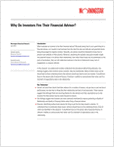According to a 2010 study by Inc. Magazine, more than 11 million formal meetings are held in the United States each day, which total more than 3 billion meetings in corporate America each year. The study found that 71 percent of employees surveyed said meetings weren’t productive. Those same employees said that of the meetings they attend, 25 percent of the time is spent on irrelevant issues.
Former President Ronald Regan once quipped, “I have left orders to be awakened at any time in case of national emergency — even if I’m in a Cabinet meeting.”
The word “meeting” has become synonymous with words like waste, boring, ineffective, long, tiring, and so on. Employees don’t like to attend meetings and employers don’t like to hold them. We’ve all been privy to ineffective meetings, long corporate presentations, and epoch conference calls that would make Alexander Graham Bell wish he’d never invented the telephone.
No one enjoys meetings, but everyone goes to them. Why? For precisely the reasons explained by the Inc. study. The act of meeting, no matter its perceptions, is critical to any businesses success. Meetings, in our minds, are necessary evils, though they don’t have to be.
The weekly staff meeting
Most, if not all businesses, have a weekly staff meeting. If your business is large enough, each division of the business may meet individually, and management may have their own separate time set aside.
Because of their nature, weekly staff meetings are often crammed full of a plethora of topics, a feeble attempt at stuffing everything into one, monumentally long gathering of minds.
Can you look yourself in the mirror and say that your weekly staff meeting is good enough? Does your weekly staff meeting maximize your team’s potential, clear channels for communication throughout different departments, answer questions and address issues that arise throughout the week? Can you accomplish all of this in one meeting? Better yet, is it wise to attempt to accomplish this in one meeting?
If you answered no to any of these questions, the “daily huddle” may be the answer to your prayers.
Verne Harnish introduced us to “Mastering the Rockefeller Habits” in 2002 and one of the greatest tools Harnish provided in the book was the concept of a “daily huddle.” Inspired by the habits of business tycoon John D. Rockefeller, Varnish outlined Rockefeller’s concept that meeting on a daily basis vastly improved the effectiveness of a business’ success and maximized employee potential.
I was introduced to the daily huddle in 2007 by Paul Sponcia, the former president of a Knoxville-based information technology firm I worked for, and have used the huddle concept in my work as a consultant, and in my current role as a director of marketing and public relations at Brogan Financial.








 March 20, 2012 at 11:58 AM
March 20, 2012 at 11:58 AM










